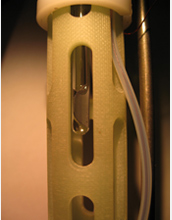All Images


Press Release 08-187
World's Smallest Storage Space ... the Nucleus of an Atom

Information lasts more than one second in hybrid quantum memory system
Back to article | Note about images
 |
In order to perfrom their experiments, the international team loaded silicon, the grey half-moon object in the middle of the tube, into a resonator. The team created a system that used both the electron and nucleus of a phosphorous atom embedded in a silicon crystal. Both the electron and nucleus behaved as tiny quantum magnets capable of storing quantum information. This allows information to stay intact for over a second, an important threshold in the development of quantum computing.
Credit: Courtesy of Stephen Lyon, Princeton University |
Download the high-resolution JPG version of the image. (292 KB)
|
Use your mouse to right-click (or Ctrl-click on a Mac) the link above and choose the option that will save the file or target to your computer.
|
 |
The silicon sample is shown in the resonator used in the experiment. The team created a system that used both the electron and nucleus of a phosphorous atom embedded in a silicon crystal. Both the electron and nucleus behaved as tiny quantum magnets capable of storing quantum information. This allows information to stay intact for over a second, an important threshold in the development of quantum computing.
Credit: Courtesy of Stephen A. Lyon, Princeton University |
Download the high-resolution JPG version of the image. (40 KB)
|
Use your mouse to right-click (or Ctrl-click on a Mac) the link above and choose the option that will save the file or target to your computer.
|
|

